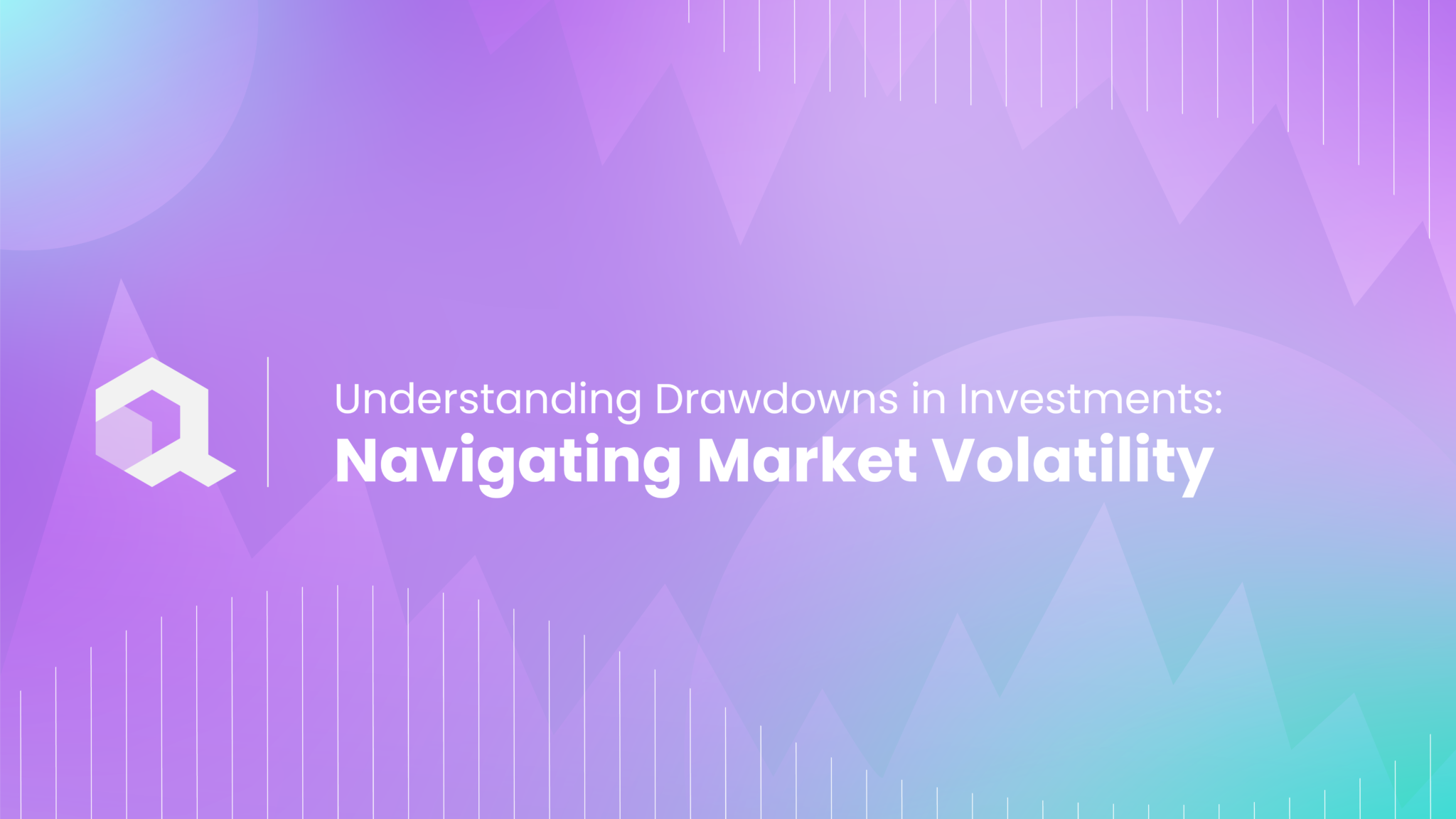
Drawdown is the decrease in the value of an investment from that highest price level downward for some specified duration of time. This is considered an acid or a barometer to estimate how much investors may lose before the portfolio can recover. The drawdown is expressed relative, meaning that it is stated in percentages, and this serves as a way of representing the relative reduction in the value of the invested money from its peak to its lowest point.
Amidst the twists and turns of this financial adventure, investors encounter a concept that holds significant weight in their experience: drawdown. We will look into complexities involving drawdowns, why they matter, and how one should deal with them to lead a person toward long-term financial profitability.
What is Drawdown?

Markets are dynamic phenomena that undergo changes from different determinants, including economic indicators, geo-political events, and investor sentiments. This volatility is manifested in drawdowns, which refer to the hurdles and difficulties that investors pass through while traveling along the path of investment. Drawdown is the decrease in the value of an investment from that highest price level downward for some specified duration of time. It is imperative that investors acknowledge the importance of drawdowns because this helps them to be psychologically prepared, set reasonable expectations, and develop workable approaches for surviving through such times.
Successful investment entails more than merely pursuing profits; it also entails navigating the drawdown. Risk management is one important factor in it. Setting stop-loss orders and diversifying portfolios by including several assets are some of the risk management strategies that can cushion investors from the impact of the drawdown. Furthermore, such a proactive stance reduces losses and helps establish rigidity against the emotional decision process during times of unsettled markets.
Also Read: Market Making: Strategies and Techniques
Drawdowns are navigated from a long-term perspective, which serves as an orientation point. People who see these setbacks as transitory disruptions on a continuous road towards success are in a far superior position to endure and survive short-term pain for permanent gain. It fosters strategic decision-making in which investors keep their sight fixed on the end goal of financial gains and shun hasty decisions that can ruin their overall investment strategy.
Further, drawdowns are often perceived as occasions rather than detriments. For instance, contrarian investors consider falling markets as opportunities to purchase assets at a bargain price. It adheres to the theory that market cyclic occurrences provide opportunities for astute acquirers who may subsequently realize gains during the following market upswing.
A sound investment trip involves understanding drawdowns and maneuvering them proficiently. With an attitude towards risk management methods, a long term approach and the acceptance that drawbacks are opportunities, one can make progress and reach long-term goals.
Why Drawdowns Matter?

One important statistic in finance is the drawdown that gives investors knowledge on investment performance and risk. The term refers to the highest-lowest fall in the price of an investment over a particular period. It exposes the genuine flexibility and unpredictability of a specified asset or portfolio.
Drawdown is the extent of a fall in expressed form as per cent from the summit, i.e., the highest mark or peak, towards its nadir or trough until a new top or peak appears. This quantification works as a measure of losses that an investor incurs when the market is not favorable and there are increased fluctuations.
Drawdown is important in a look back analysis of a portfolio and has a bearing on what investments to make in the future. Smart investors carefully consider drawdowns as an indicator of risk for improved portfolio management and resilience post downturn. Knowledge about drawdowns enables traders to make educated choices, adjust their perceptions towards the potential downsides of capitalization, and maximize their wealth through sustained accumulation.
One has to bear in mind that different investment tools like stocks, bonds, or mutual funds have different drawdown levels depending upon market conditions and the intrinsic features of the underlying assets. Additionally, the drawdown period and number of events have a significant impact on the overall risk associated with an investment.
Therefore, drawdown is an important measure in finance that allows investors to assess the strength and susceptibility of their stocks. Knowing the subtleties of a drawdown allows investors to overcome the market waves using the right strategies aimed at achieving their financial goals.
Navigating Drawdowns

Successful investors know how to cope with drawdowns. This is an integrated approach that includes some tactical considerations, risk minimization, and a sound mental attitude. Let’s delve deeper into the variables that influence dealing with downswings.
– Diversification
Diversification stands as one of the main strategies for increasing the robustness of an investment portfolio. Investors spread their investments among equities, fixed income, real estates and commodities in order to minimize exposure to sector specific drawdowns. This approach is based on the assumption that different assets react to economic conditions, market trends, and geopolitical events differently. As such, when one asset class goes down, other asset classes could be stable or go up, thereby reducing potential losses and giving a net-portfolio return.
For example, during times of economic decline, certain types of assets, such as bonds and precious metals, tend to be more stable and could even rise against the turbulence usually experienced within stock markets. This diversification is aimed at mitigating significant losses and providing a better investment experience that can absorb market fluctuations smoothly.
– Risk Management
Risk management is a preventive approach for saving money in capital and diminishing losses incurred during market downturns. Stop-loss orders, which are among the crucial utilities of the risk management package, can assist traders. These orders are considered to be a preordained system for the sale of the asset at a particular price. Investors set themselves off by providing for their exit strategy, thereby keeping their emotions in check when the market swings and capping how much loss they can suffer with stop-loss orders.
Effective risk management starts with an understanding of the risk-return profile of investments. Investors should analyze the specific risk attached to each asset, taking into account volatility of prices, state of markets, economic indicators, etc. In conclusion, this detailed analysis helps investors set up their portfolios based on their risk tolerance and financial goals while considering possible future drawdowns.
– Regular Portfolio Review
Rebalancing is an essential aspect of any investment environment. The markets always change, and asset performance is constantly evolving. Investors can always be repositioned based on regular portfolio reviews, as this keeps their footing flexible to the changing trends of the markets. On the other hand, investors should measure the rate of return for every asset and as a whole with the purpose of realignment in case it is necessary and maximizing the risk adjusted performance.
Re-balancing is done by rearranging how assets are allocated and distributed in accordance with their returns and market trends. For instance, if an asset class has been leading in performance, its weight in a portfolio may have to be lowered in order to match a certain level of risk. On the other hand, if a particular asset class has performed poorly in the past, an investor could increase his exposure to that area of investment and realize some gain. The iterative nature of this procedure guarantees that the portfolio is not static but adapts to changing markets.
Multiple Perspectives on Drawdowns
A better view of withdrawals gives room for a deeper appreciation of the possible effects and what investors can do about them. Multiple views on drawdowns are here.
– Short-Term Pain, Long-Term Gain
This kind of perception about markets being cyclic, where they have seasons of rise and fall, is what makes up their cores. Far from aberrations, drawdowns are considered inextricable parts of a greater investment environment. These investors believe that their portfolio has to be driven by a panoramic trajectory across several market cycles. The foundation of these strategies lies in accepting short term pain as a prerequisite for long term gains and compound returns.
Such investors embrace the cyclical nature of the financial markets and look at drawdowns as a normal part of the investment journey. They are aware that market cycles involve a time of excitement and stagnation, and both sides present their own advantages and disadvantages. These investors put their mindset in line with market cycles, ensuring they take rational decisions that move beyond the effects of drawdowns.
– Opportunity Amidst Challenges
While conventional wisdom might think of drawdown periods as troubling downturns to fear, contrarian investors actually view them as promising prospects for discovery. A special approach to thinking recognizes bear market conditions as an opportunity to buy assets cheaply. Contrarian investment style was established on the belief that markets tend to overshoot during price moves downwards or drawdowns, and therein lie opportunities.
Draw-downs are the best times for contrarians who make money off the fear and lack of certainty present. They see such times as opportunities, knowing that people commonly undervalue assets when they are emotional. They choose the most advantageous moment during a bear market to profit afterwards in times of a bull market.
However, contrary investing is only possible when one goes against the trending sentiments of the markets. During such times, most people will give into panic selling and become pessimistic. Contrarily, contrarians tend to build positions into assets that happen to be temporarily underpriced. First, they need to have a strong belief in their analysis and willingness to accept short term market disbelief with confidence that their long run strategy will finally prevail later on.
Also Read: Market Maker Options: Definition and How They Make Money
– Caution and Preservation
In general, conservative investors avoid the temptation of high profits from increased risk. In return, the safety of the accumulated capital is their prime concern. This conservative approach acknowledges lower profits while experiencing a bullish phase because the main goal is constant accumulation and not some unpredictable but outstanding results.
In the case of the conserver method, the assets are allocated so as to minimize risk. These kinds of assets are attractive to conservative investors, such as high-quality bonds or shares that pay out dividends. Such assets have stable revenue streams and prove more durable in times of market fallout. Such an approach to measuring distribution reduces exposure to riskier markets’ volatility, leading to lower risk and expected returns.
Conservative portfolios usually prioritize stable investments that yield good returns. The bulk of the portfolio is made up of dividend paying stocks, bonds, and other income earning assets. Consistent cash flow with added protection in case of capital loss during market recessions is provided by an asset with constant dividends.
Conclusion
The phases of the investment journey where investment values are decreasing are called drawdowns, and they become integral parts of this narrative. Drawdowns go beyond being just mere statistical fluctuations and represent real-time stress tests that examine the validity and emotional endurance of investing strategies. Therefore, successful navigation through this phase necessitates a multipronged approach such as understanding, active risk management and having a strong long term focus.
Understanding drawdowns is fundamental. An obvious feature of financial markets is those downturns, which can be measured in terms of perks-to-bottom troughs. Investors can set their expectations on a realistic note by considering them as an unavoidable part of the investment environment. With this knowledge in hand, investors can psyche themselves up to face the reality that drawdowns are part of the investing game and, thus, should not allow their emotional responses to dictate the way they react to sudden changes in the market.
Another essential consideration in the approach to drawdowns is implementing effective risk management strategies. Using stop-loss orders as an instrument for setting up exit points allows defining a systematic strategy for reducing losses at the time of markets’ fall. Protected capital and the avoidance of emotional decisions during unstable times are typical problems in crisis situations. Moreover, diversification, asset allocation and others are all part of the robust methodology for risk management and improving the resistance of the portfolio to the effects of decline.
Disclaimer: The information provided by Quant Matter in this article is intended for general informational purposes and does not reflect the company’s opinion. It is not intended as investment advice or a recommendation. Readers are strongly advised to conduct their own thorough research and consult with a qualified financial advisor before making any financial decisions.

I craft stories that make complex ideas clear. I simplify the blend of data science, machine learning, and crypto trading, showcasing how advanced tech and quantitative models analyze data for informed trading choices. Join me in exploring the realm of quantitative trading, where my narratives make intricate concepts easy to grasp.
- Alifia Berizkyhttps://quantmatter.com/author/alifia-berizky/
- Alifia Berizkyhttps://quantmatter.com/author/alifia-berizky/
- Alifia Berizkyhttps://quantmatter.com/author/alifia-berizky/
- Alifia Berizkyhttps://quantmatter.com/author/alifia-berizky/
